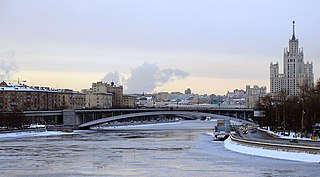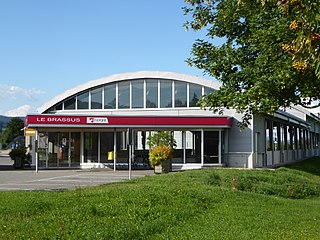
Beam bridges are the simplest structural forms for bridge spans supported by an abutment or pier at each end. No moments are transferred throughout the support, hence their structural type is known as simply supported.

A girder bridge is a bridge that uses girders as the means of supporting its deck. The two most common types of modern steel girder bridges are plate and box.

Bolshoy Krasnokholmsky Bridge is a steel arch bridge that spans Moskva River in downtown Moscow, Russia, carrying Garden Ring between Tagansky District and Zamoskvorechye Districts. It was completed in 1938 by V.M.Vakhurkin, G.P.Golts and D.M.Sobolev. Its main span is the widest arch span in Moscow.

Lausanne railway station is the main intercity and regional railway station for the city of Lausanne, Vaud, Switzerland. It is often known as Lausanne CFF to distinguish it from others in the town.

The Waldshut–Koblenz Rhine Bridge is a single-track railway bridge on the Turgi–Koblenz–Waldshut railway, between Waldshut and Koblenz AG, crossing the Rhine and the border between Germany and Switzerland. It was the first railway bridge built over the Rhine below Lake Constance. It is the only major railway bridge over the Rhine, which is completely preserved in its original condition and is one of Europe's few lattice truss bridges. It is also one of the oldest railway bridges in the world.

Vallorbe railway station is a station at the border of Switzerland and France on the TGV Lyria line between Paris and Lausanne. It is located at the south-eastern entrance of the tunnel which tunnels one of Jura's mountain ranges, Le Mont d’Or. The station serves the municipality of Vallorbe, in the Canton of Vaud, Switzerland.

The Caledonian Railway Bridge is a bridge crossing the River Clyde at Broomielaw in Scotland. It is adjacent to Glasgow Central Station.

Paul Séjourné was a French engineer who specialized in the construction of large bridges from masonry, a domain in which he made some important innovations.

The Simplon Railway is a line that links Lausanne in Switzerland and Domodossola in Italy, via Brig. The 20 km (12 mi)-long Simplon Tunnel is a major part of it. The line between Lausanne and Vallorbe is sometimes considered to form part of the line, making it 233 km (145 mi) long.

The Verrières Viaduct is a curved 720-metre concrete autoroute box girder bridge in the south of France, which at one point was briefly the highest bridge in France; it is almost 500 feet tall.

The Pont–Vallorbe Railway was a Swiss railway company that existed from 1886 to 1891. Its short railway line is now owned by the Swiss Federal Railways (SBB). The SBB operates the line from Vallorbe through to Le Brassus. The extension from Le Pont to Le Brassus used to belong to the Pont–Brassus Railway, but since 2001 it has been owned by Travys.

The Pont–Brassus Railway was a railway company in the Swiss canton of Vaud. It built a standard gauge line from Le Pont parallel to the north shore of the Lac de Joux to Le Brassus. The line has been owned by the Travys regional transport company since 2001. Passenger traffic on the line is operated by Swiss Federal Railways (SBB). Trains run continuously from Vallorbe via Le Pont to Le Brassus. They operate hourly on non school days and half-hourly on school days.

The Grandfey-Viaduct is on the railway line from Bern to Fribourg and is one of the largest bridges in Switzerland.
The Jougne-Eclépens Railway was a railway company in Switzerland and existed from 1870 to 1876.

Le Day railway station is a railway station in the municipality of Vallorbe, in the Swiss canton of Vaud. It sits at the junction of the standard gauge Simplon line of Swiss Federal Railways and Vallorbe–Le Brassus line of SBB and Travys.

The R3 is a railway service of RER Vaud that provides hourly service between Vallorbe and Aigle in the Swiss canton of Vaud. A limited number of trains continue to St-Maurice. Swiss Federal Railways, the national railway company of Switzerland, operates the service. The service was previously known as the S3.

The R4 is a railway service of RER Vaud that provides hourly service between Le Brassus and Aigle in the Swiss canton of Vaud. A limited number of trains continue from Aigle to St-Maurice. On weekdays, a section of the train operates from Le Day to Vallorbe. Swiss Federal Railways, the national railway company of Switzerland, operates the service. The service was previously known as the S4.

The Gien viaduct is a railway bridge crossing the Loire at Gien in the Loiret and the Centre-Val de Loire region. It was part of the Gien - Argent railway line of which today only the Gien - Poilly-lez-Gien section is still in service, for the transport of goods.

Le Brassus railway station is a railway station in the municipality of Le Chenit, in the Swiss canton of Vaud. It is the western terminus on the standard gauge Vallorbe–Le Brassus line of Swiss Federal Railways and Travys.


















